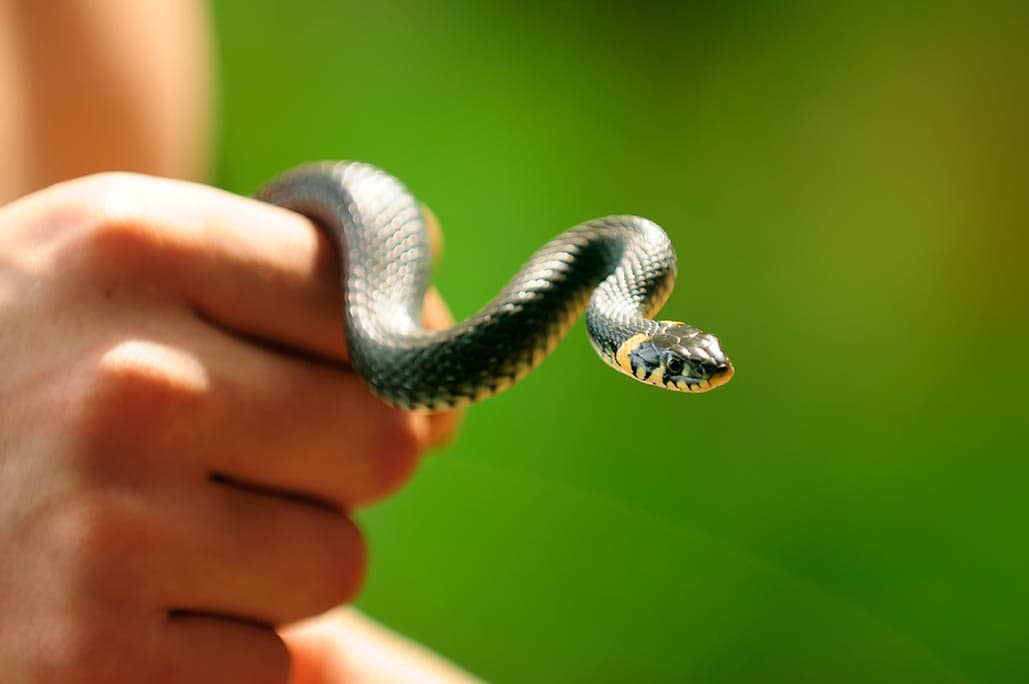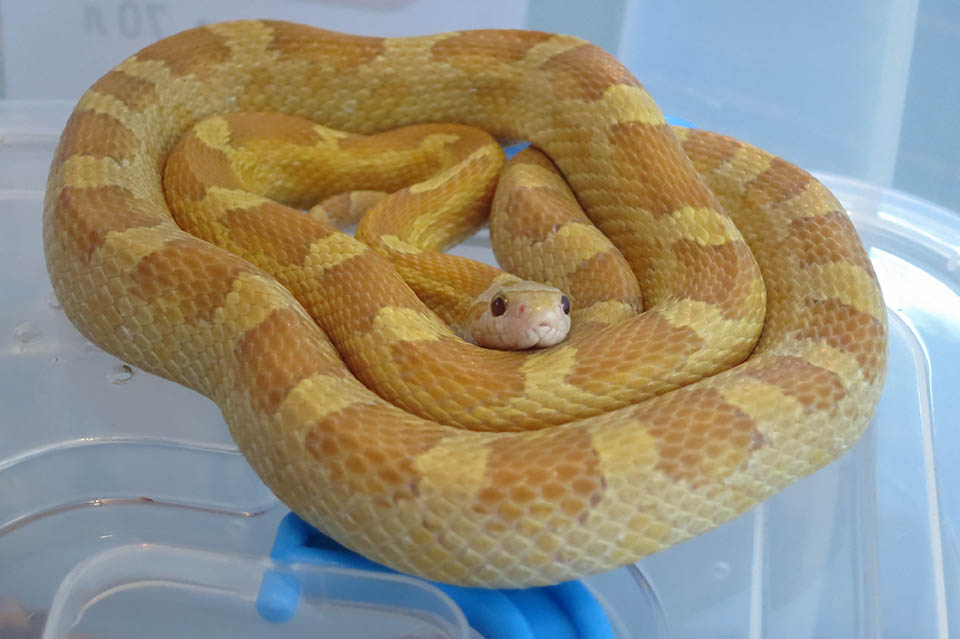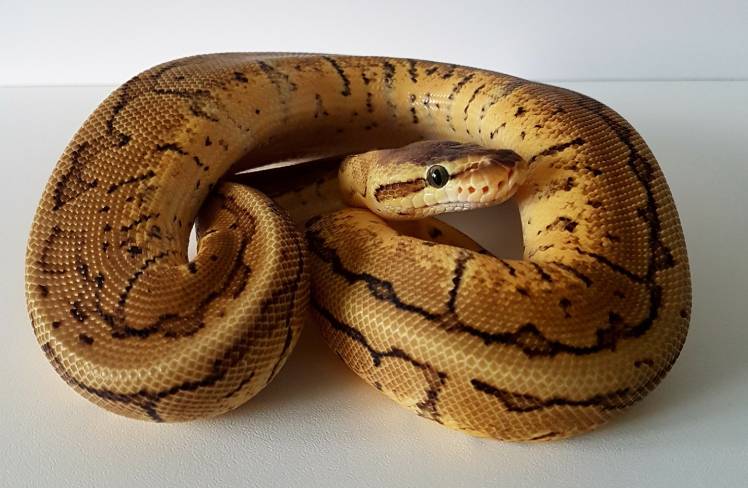
The Lemon blast ball python is a morph of the ball python snakes. Ball pythons got their name from their habit of curling into a ball when stressed or frightened. They are the most popular snake species among reptile lovers.
Ball pythons are native to Africa, and they are also called Royal pythons. In this guide, we will look a little deeper into keeping the lemon blast ball python as a pet, how to feed them, handle them, and generally take care of them. Keep reading to find out more.
Quick Facts about Lemon Blast Ball Python

| Species Name: | Python regius |
| Common Name: | Lemon blast ball python |
| Care Level: | Easy to handle |
| Lifespan: | 20-30 years |
| Adult Size: | 4-5 feet long |
| Diet: | Carnivore (Live & frozen-thawed mice) |
| Minimum Tank Size: | 36-inch by 18-inch by 12-inch |
| Temperature & Humidity: | 80-95°F
50-60% |
Do Lemon Blast Ball Python Make Good Pets?
Lemon blast ball pythons are adorable and docile snakes that make good pets. Their friendly nature makes them a perfect choice for both first-time snake owners and experienced owners. They are easy to maintain and care for because they do not require much.
Their small sizes make them easy to handle. They usually feed once a week and don’t need a lot of attention. You only have to hold them at least once a week and for about twenty minutes each time. This helps them to get used to you and creates a bond between the both of you.
Appearance
The lemon blast ball pythons are beautiful designer morphs of two intricately patterned and colored ball python breeds. They are created from the breeding of the pastel and the pinstripe ball pythons.
The lemon blast ball pythons have the fine line patterns of a pinstripe and the bright yellow colorful appearance of a pastel. Their eyes are green in color, and their underbellies have a solid white color.
- Related Read: Do Ball Pythons Recognize Their Owners?
 How to Take Care of Lemon Blast Ball Python
How to Take Care of Lemon Blast Ball Python
Tank
The tank should be spacious to enable easy movement. Divide it into two parts for cool and warm sides, then place hiding boxes on each side. Your pet will need a hiding place because they enjoy privacy and hiding from time to time.
Spot cleaning should be done immediately. Full cleaning should be done weekly. Remove everything and wash it in 5% bleach before rinsing thoroughly and drying. Replace all accessories and substrate in the enclosure.
Lighting
Lemon blast ball pythons do not require lighting. The natural light in a room is enough because they are nocturnal animals who are most active at night. If you are using lighting, ensure that the light is on for 12 hours and off for 12 hours to avoid confusing them.
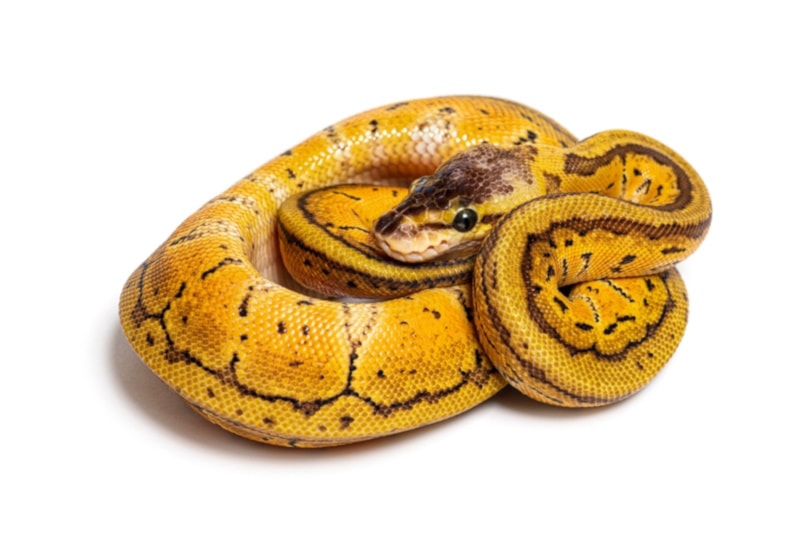
Heating (Temperature & Humidity)
The tank should have a cool area at 80-85°F temperatures and a warm area at 90-95°F to enable thermoregulation. Under-tank heating pads, ceramic heat emitters, and basking bulbs are great for providing warmth. Avoid hot rocks as they can lead to serious burns on direct contact.
The humidity levels should be at 50-60%. Proper humidity helps your python to shed properly.
Substrate
Good substrates to use are newspapers, paper towels, and aspen shavings. Avoid using cedar and pine shavings because they can cause respiratory tract problems in your pet.
Tank Recommendations
| Tank Type: | 36-inch by 18-inch by 12-inch glass terrarium/tank |
| Lighting: | N/A |
| Heating: | Heating pads/ceramic heat emitters |
| Best Substrate: | Aspen shavings |

Feeding Your Lemon Blast Ball Python
Small lemon blast ball pythons need feeding weekly, while adults can be fed every one to two weeks. You can buy prey online or at pet stores. Feed young snakes with smaller mice. Always ensure that the prey is as big as the python’s biggest body width.
You can feed your pet with live or frozen-thawed mice. When feeding live mice, stick around because they can bite and scratch the pet, causing serious injuries that can be fatal. Frozen mice are safer and easier to store.
Sometimes your python will refuse to eat during certain periods like winter or when they are shedding. That’s normal but keep feeding them every 10-14 days until they resume eating.
Diet Summary
| Fruits | 0% of diet |
| Insects | 0% of diet |
| Meat | 100% of diet- small/medium-sized rodents |
| Supplements Required | N/A |
Keeping Your Lemon Blast Ball Python Healthy
A healthy lemon blast ball python will generally be active, have healthy skin, normal eating habits, regular shedding, and will not have ticks.
Common Health Issues
Common health issues include dermatitis, respiratory diseases, stomatitis, ticks, and mites. Signs are irregular shedding, vomiting, lethargy, lack of appetite, abnormal feces, trouble breathing, white substance in the mouth, parasites on skin, and mucus in mouth or nostrils.
The issue can be easily contained by cleaning their habitat, lowering humidity, or keeping the python warm. However, always consult a veterinarian because some issues like stomatitis can be serious and even fatal.
Full body examinations should be done every 6 months, while fecal exams should be done every 12 months to check for parasites. Always consult a veterinarian in case you notice something unusual or have some concerns.
Lifespan
The lifespan of a lemon blast ball python is 20-30 years. There have been records of up to 40 years. Different factors will reduce a python’s lifespan, like their diet, housing environment, stress, and health issues. As long as the pet is well taken care of, they will stay healthy and live longer.
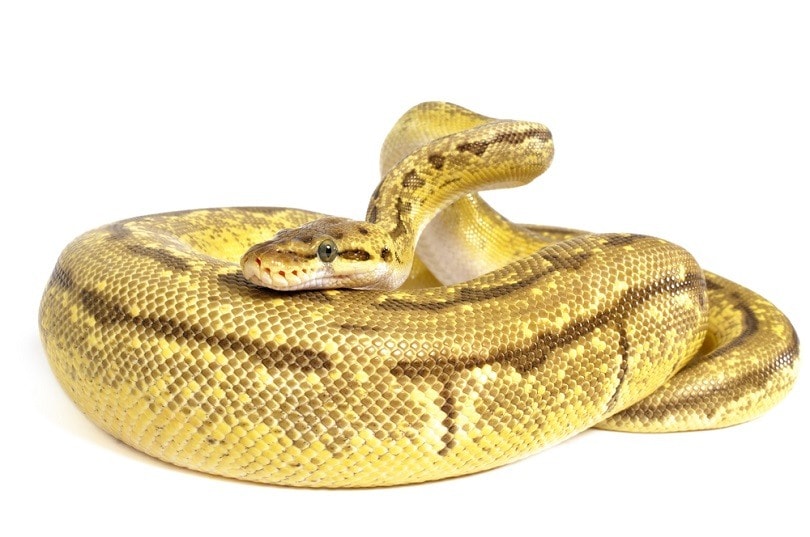
Breeding
Breeding should not be done in tanks due to inconsistency in heat and humidity. When building and laying eggs, female lemon blast ball pythons need higher humidity and privacy. A good breeding enclosure would be a rack.
The minimum breeding age for females is 2-3 years. At this age, most of them have attained the minimum weight of 1,200g. Breeding female pythons should be healthy and thick. Males mature faster, and their breeding age is 1 year or less. They are generally smaller in size, and their minimum weight is 700g.
Always ensure that both pythons are the right sizes before breeding. If not, females may become egg-bound and be unable to pass eggs, while the male may stop eating during breeding and have serious weight loss that could be dangerous to their health.
Are Lemon Blast Ball Python Friendly? Our Handling Advice
Lemon blast ball pythons are friendly pets. They don’t mind handling, and some even enjoy it. Ensure you handle them regularly and not only when you are feeding them so that they don’t associate you opening their enclosure with food.
Handling will make your pet active but avoid overhandling. Keep it to a minimum of 1-3 times a week and never twice a day to prevent stress.
Avoid handling them when they are new. Give them a week or two to get used to their environment and stop seeing you as a threat. Many pythons are agitated while shedding, too, so give them space.
Do not handle your python after feeding as they may regurgitate. Give them 2 hours for digestion before handling.
Shedding & Hibernation: What to Expect
When the shedding cycle approaches, your pet’s appetite levels may drop, and they could stop feeding altogether. Their eyes gradually turn to a milky blue/greyish color. Their bodies will also begin to have a dull and whitish sheen begin to appear.
They may also become irritable. When you notice these changes, avoid handling as much as possible and only interact with them while giving them food or changing their water.
Ensure the humidity levels in the enclosure are at the right levels. Do not remove their eye caps by yourself but seek the help of a veterinarian.
How Much Do Lemon Blast Ball Python Cost?
Considering the long lifespans of a lemon blast ball python, acquiring the pet should not be an impulsive purchase. It is a great responsibility, and enough preparation should be done beforehand.
The lemon blast ball python is not costly and could cost between $50 to above $200. One can be purchased from a specific breeder, online, or from a pet store.
Initial costs will be around $350, with ongoing annual costs being $150. The costs include the price of the pet, enclosure, accessories, food, and veterinary costs. Accessories include heating pads, lighting, thermometer, water bowl, hiding boxes, and substrate.
Care Guide Summary
 Final Thoughts
Final Thoughts
Lemon blast ball pythons are easy-to-keep pets that are shy and could spend a lot of their time in hiding. The pets do not trigger allergies, making them a snake pet favorite for most.
However, they are escape artists and could escape and be hard to find.
Keep them in a well-ventilated enclosure that is not too big because big spaces overwhelm younger pythons.
Feed them weekly and provide fresh, clean water daily. Sometimes they could defecate in the water bowl, so keep it clean and disinfected. Handle them regularly but avoid overhandling to avoid stressing them.
Featured Image Credit: Deb Davis, Shutterstock

 How to Take Care of Lemon Blast Ball Python
How to Take Care of Lemon Blast Ball Python
